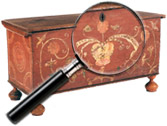|
|
Wolfgang Rabl (Austrian, born 1942)
Wolfgang Rabl studied art techniques at the Akademie der Bildenden Kunste, Vienna, in 1964 and 1965. At this time Vienna was the center for the influential movement known as ‘Fantastic Realism’. Generally, Fantastic Realism combines extreme realism with either fantasy or elements of the unconscious. The movement was officially founded in 1947 by such artists as Rudolf Hausner (1914-1995), Wolfgang Hutter and Anton Lehmden. Another well known representative was [...] Click here to continue reading.
The Schlegelmilch Porcelain Works
Fine molded porcelain with transfer or hand-painted decoration was manufactured from the early 1860′s until the advent of World War I by two independent families sharing the name Schlegelmilch in the Germanic state of Prussia and Silesia. (Prussia was later incorporated into East Germany and is now a part of modern Germany; Silesia was then considered to be German Poland).
R.S. Prussia
The most well known and widely collected of [...] Click here to continue reading.
R. J. Horner & Co.
The firm of R. J. Horner & Co., established in 1886 on East 23rd Street in New York City, produced an assortment of furniture predominantly in the Aesthetic Movement style. They often identified their products with porcelain placques nailed to the individual pieces. Horner first advertised imitation bamboo made of maple in 1890 as the Japanese aesthetic became popular as a result of the 1876 Centennial Exposition in Philadelphia. [...] Click here to continue reading.
Ernest J. Bellocq (1873 to 1949), Photographer
Little is known about the life of New Orleans commercial photographer Ernest J. Bellocq and his involvement with photographing prostitutes of Storyville, the Red Light District of New Orleans. Whether it was Bellocq who scratched out the faces of the prostitutes on glass plate negatives remains a mystery. It has been speculated that he scratched out their faces to protect the identity of the Storyville girls.
After [...] Click here to continue reading.
John Bellamy
John Haley Bellamy, master ship carver of Kittery Point, Maine produced some of the most outstanding decorative carving for ships and buildings during the last half of the 19th century. Bellamy was best known from his carved eagles which were characterized by concave wings, a deep cut eye and accentuated beak. He used a minimum of carving to achieve a masterful effect of clean simplicity. In addition to eagles, Bellamy carved animals, [...] Click here to continue reading.
Walter Emerson Baum, ANA (1884-1956)
A son of Bucks County, Walter E. Baum was born in the town of Sellersville in 1884 and died there in 1956.
Considered by many to be “the father of art in the Lehigh Valley”, Baum was a founder of the Lehigh Art Alliance in the pre-WWII era and was director of the Allentown Museum of Art, as well as of his own Baum School of Art, and art [...] Click here to continue reading.
John Pierce Barnes (1893 to 1954)
This Philadelphia native painted in Collingsdale, Pennsylvania and studied at the Philadelphia School of Industrial Design and The Pennsylvania Academy of Fine Arts. As his painting talent grew and his passion for art progressed, Barnes was given the opportunity to study abroad in Europe for two years. His work was exhibited through the PAFA and he received both the Cresson Traveling Scholarship and the Second Tappan Prize awards [...] Click here to continue reading.
James Bard (American, 1815 to 1897) – Ship Portraitist
Working in Greenwich Village, New York, James Bard and his twin brother John collaborated together in the early nineteenth century and became the preeminent maritime artists of their time. After the American Revolution and War of 1812, the young American republic experienced a burst of financial growth and national pride. Paintings of sailing ships and steamers, which depicted the speed, beauty and advancements in industry [...] Click here to continue reading.
Barcelona Chair
The Barcelona chair and a matching stool (or ottoman) were designed in 1930 by Ludwig Mies van der Rohe for the German Pavilion at the 1929 Barcelona Exposition in Spain. A couch was designed in 1930 to accompany the collection. A coffee table was also created. The items are still produced by Knoll, which acquired the exclusive manufacturing and sales rights from the designer in 1953. Mies van der Rohe based his [...] Click here to continue reading.
Banthrico Coin Banks
The Banthrico name and origin can be traced to Chicago in 1931 when Jerome Aronson and Joseph Eisendrath purchased the Banker’s Thrift Corporation. Banker’s Thrift had joined forces with the Stronghart Company in 1929 and had become a well-known maker of small steel building banks. The new owners shortened the name to ‘Banthrico’ and continued the already established line of promotional banks. Early success led to the purchase in 1940 of [...] Click here to continue reading.
|
Recent Articles
- Charles Alfred Meurer – American Artist & Tromp L’Oeil Artist
- Sendak, Maurice – American Artist & Writer
- Godie, Lee – American Artist
- Davis, Vestie – American Artist
- Bartlett, Morton – American Artist
- Mackintosh, Dwight – American Artist
- Evans, Minnie Jones – African-American Artist
- Mumma, Ed (Mr. Eddy) – American Artist
- Nice, Don – American Artist
- Savitsky, John (Jack) – American Artist
- Gordon, Harold Theodore (Ted) – American Artist
- Dial, Thornton – African-American Artist
- Doyle Sam – American Artist
- Johnson, Lester Frederick – American Artist
- Finster, Howard – American Artist
|
|
